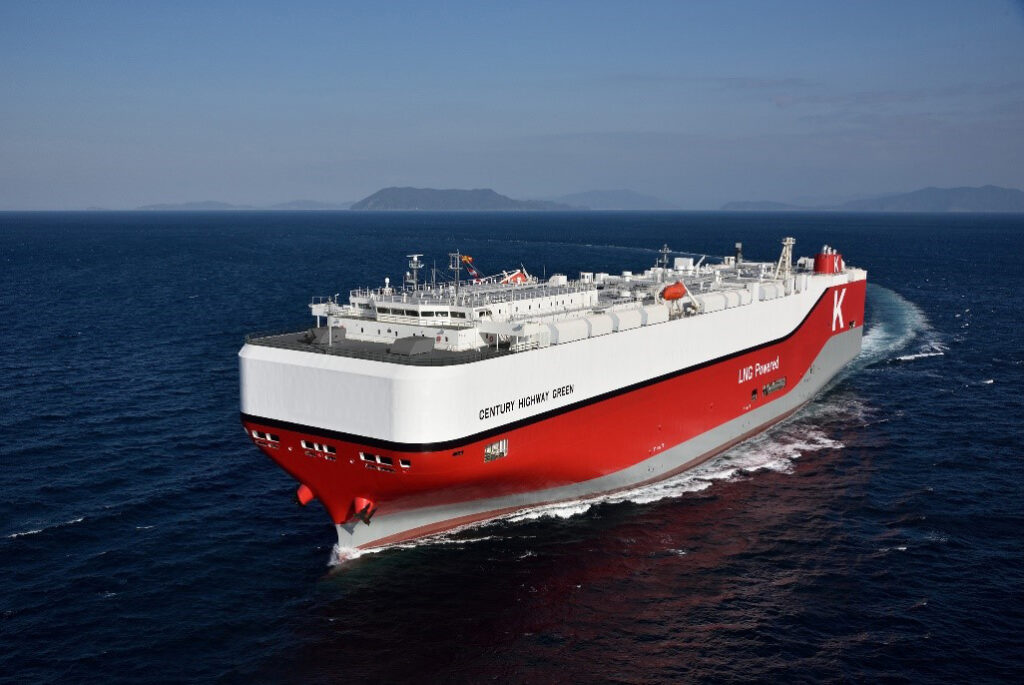On March 12, the “CENTURY HIGHWAY GREEN”, a car carrier fueled by LNG (liquefied natural gas) that had been under construction at Tadotsu Shipyard Co., Ltd., part of the Imabari Shipbuilding Group, has been delivered to “K” LINE.

She is a next-generation environmentally friendly vessel expected to reduce emissions of carbon dioxide (CO2), which is a greenhouse gas (GHG) by 25% to 30%(*1), emissions of sulfur oxides (SOx), which cause air pollution, by almost 100%, and emissions of nitrogen oxides (NOx) by 80% to 90% with the use of Exhaust Gas Recirculation (EGR) in addition to the use of LNG fuel, compared to conventional vessels using heavy fuel oil. The launch of “K” LINE’s first LNG-fueled car carrier realizing transportation with a low environmental impact is an important milestone for achieving the targets set forth in the “K” LINE Environmental Vision 2050(*2).
In addition, a remote naming ceremony was carried out on March 3, ahead of the vessel’s delivery. Four locations in Aichi, Kagawa, Okayama, and Tokyo were connected online, with attendees including Toyota Motor Corporation (head office: Toyota-city, Aichi; President and Representative Director: Akio Toyoda) Chairman and Representative Director Takeshi Uchiyamada and his wife, Ministry of Land, Infrastructure, Transport and Tourism Maritime Bureau Director-General Shinichiro Otsubo, Ministry of the Environment Chugoku-Shikoku Regional Environmental Office Director Kenji Kamita, Imabari Shipbuilding Co.,Ltd. President Yukito Higaki and “K” LINE President and Representative Director Yukikazu Myochin. The vessel was named by adding the word “GREEN” evoking images of harmony with the planet and the environment to the traditional name of “CENTURY HIGHWAY” that has been used in four of “K” LINE’s car carriers in the past.
The vessel utilizes a variety of environmental measures and digital technologies in an effort to improve safety, environment, and quality that are important issues for “K” LINE
Overview of the Vessel
Length of over all : 199.98 meters
Beam : 37.2 meters
Maximum number of cars loaded : 7,080 vehicles
Gross tonnage : 73,515 tons
LNG fuel tank capacity : 2,439 cubic meters
Registry : Japan
- Environmental Specifications of the Vessel
- The vessel uses a dual fuel main engine and auxiliary engines (generator, boiler) capable of operating on either LNG or Marine Gas Oil (MGO). The main engine uses a high-pressure type ME-GI engine, reducing emissions of methane slip (unburnt gas), which is a greenhouse gas.
- The main engine utilizes EGR and the generator utilizes Selective Catalytic Reduction (SCR), clearing NOx Tier III regulations when using either LNG and MGO fuel.
- The construction of the vessel received support of the “Model Project for Measures to Reduce Emissions of CO2 from Vessels Utilizing Alternative Fuels” that is a joint project by the Ministry of the Environment and the Ministry of Land, Infrastructure, Transport and Tourism.
- Part of the construction funding for the vessel was procured from Mizuho Bank, Ltd. and Sumitomo Mitsui Trust Bank, Limited through Japan’s first climate transition loans.
Please see <Related Links>.
- The vessel is equipped with training vessel specifications to promote the spread of LNG-fueled vessels and the reduction of greenhouse gases. An issue for the expansion of LNG-fueled vessels is the acquisition of IGF(*3) qualifications by the captain, chief engineer and all engineers. The requirements of IGF include on-board training on an LNG-fueled vessel, and this vessel has been designed from the outset with a maximum crew of 50, which is one of the largest crew capacities in the world, to enable many crew members to train on board.
- Digital Technologies Installed on the Vessel
- Expansion of on-board Wi-Fi
In addition to residential area, Wi-Fi has been installed on the cargo deck and in the engine room and LNG fuel-related equipment compartment with the aim of improving efficiency of operations such as remote monitoring of the vessel interior.
- Installation of cameras inside the vessel
Several web cameras have been installed on the cargo deck and in the engine room, enabling real-time monitoring via PC or mobile phone within the vessel via the on-board Wi-Fi. Recording is also possible, enabling monitoring of the conditions on board from land via the Internet.
- Utilization of mobile devices
On-board Wi-Fi can be used to share audio, video, text communication, and electronic files using smartphones and smart glasses, enabling the improvement of operational efficiency, reduction of workload, and strengthening of communication among crew members. These devices are also utilized for ship-to-shore audio and video communication.
- Dual fuel generator preventative diagnosis system
The vessel is equipped with “ClassNK-CMAXS” made by Nippon Kaiji Kyokai as the generator status diagnostic system for preventing serious failures based on the early detection of engine anomalies.
(*1) Based on EEDI (Energy Efficiency Design Index), the vessel is expected to reduce CO2 by approximately 45% ,which is higher than Phase-3 target of more than 30% reduction applied for new vessels with contract date after 2025.
About EEDI : https://www.kline.co.jp/en/csr/environment/regulation.html
(*2) “K” LINE Environmental Vision 2050 is a long-term vision on the environment established by “K” LINE in 2015. It was revised in June 2020 to set the target of “improving CO2 emission efficiency by 50% compared to 2008” which exceeds the International Maritime Organization (IMO) target for 2030 of “40% improvement,” and “introduction of LNG-fueled vessels” was set forth as an action plan for achieving this.
(*3) The “International Code of Safety for Ships Using Gases or other Low-flashpoint Fuels” (IGF Code) established by the International Maritime Organization (IMO).






